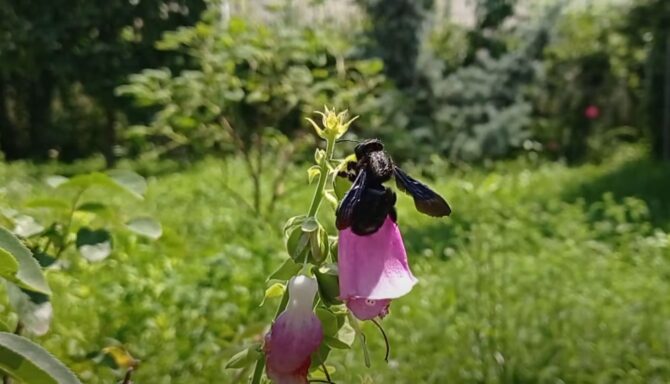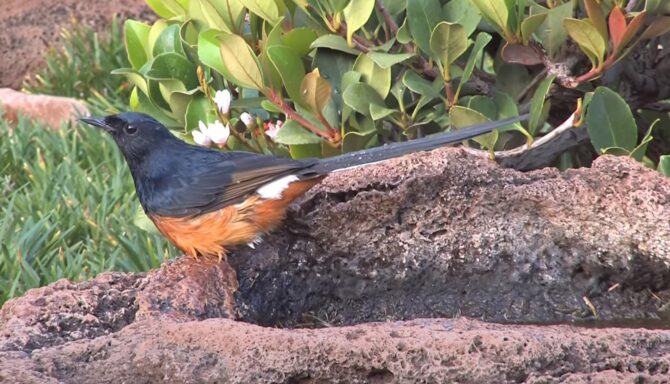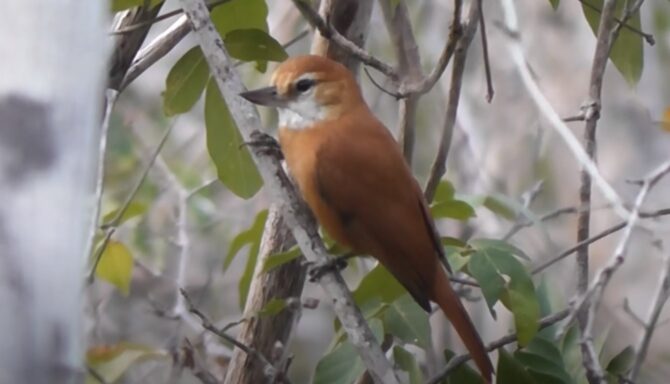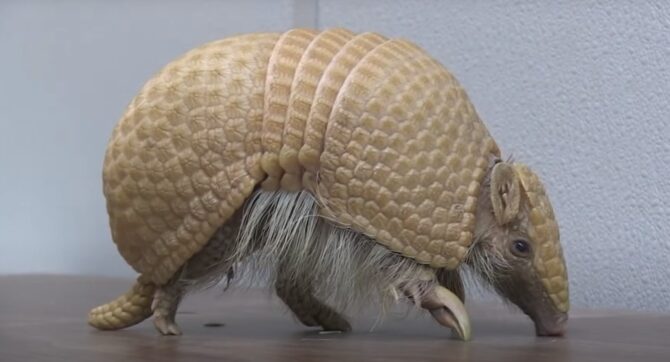At first thought maybe you wouldn’t find so many animals that start with “X”. But don’t worry, we did it for you. It wasn’t easy to find so many different species.
However, we did our best to make it interesting.
While some starting letters are the beginning of only a few animals, like here, or others our lists don’t have so big numbers, the problem with the letter X was because these creatures are not so famous.
63. Xantus’s Murrelet
The Guadalupe murrelet or Xantus’s murrelet is a small seabird found in the California Current system in the Pacific Ocean. This auk breeds on islands off California and Mexico. It is threatened by predators introduced to its breeding colonies and by oil spills.
The penguin-like Xantus’s murrelet is a striking example. These murrelets were decimated by predation as feral cats and rodents spread across their island homes in Southern California and Baja California, Mexico.
“The Xantus’s Murrelet, a gem of the Pacific, faces threats from both land and sea, reminding us of the delicate balance of nature.” – Dr. Maria Gomez, Marine Biologist
62. Xeme
The Xeme is a small gull that is easy to identify through its striking wing pattern.
It is the only species placed in the genus Xema. It breeds in colonies on coasts and tundra, laying two or three spotted olive-brown eggs in a ground nest lined with grass.
The adult has a pale grey back and wing cover, black primary flight feathers, and white secondaries.
The whitetail is forked. The male’s hood darkens during the breeding season.
“The Xeme’s flight, a dance over the Arctic tundra, is a spectacle of nature’s artistry.” – Alexander Petrov, Ornithologist
61. Xenarthra
The name Xenarthra derives from the two ancient Greek words ξένος (xénos), meaning “strange, unusual”, and ἄρθρον (árthron), meaning “joint” Xenarthra is a major clade of placental mammals native to the Americas.
There are 31 living species: the anteaters, tree sloths, and armadillos. Extinct xenarthrans include the glyptodonts, pampatheres, and ground sloths. Xenarthrans originated in South America during the late Paleocene about 60 million years ago.
Xenarthrans share unique features including supplementary intervertebral articulations, internal testes, and low metabolic rates.
“Xenarthrans, with their unique evolutionary adaptations, are a testament to the diverse tapestry of life in the Americas.” – Dr. Luisa Fernandez, Evolutionary Biologist
60. Xenops
Xenops is a genus in the bird family Furnariidae, the ovenbirds.
The genus comprises four species of xenops, all of which are found in Mexico, Central America and South America, particularly in tropical rainforests (in the Amazon rainforest and in the foothills of the Andes).
“In the dense foliage of the Amazon, the Xenops crafts its life, a small bird with a big role in the ecosystem.” – Eduardo Silva, Tropical Ecologist
“The Xenopus frog, a vital tool in scientific research, offers insights into the complexities of life itself.” – Dr. Raj Patel, Biomedical Researcher
59. Xerus – Xerini
Xerus – Xerini is a tribe of ground squirrels occurring in Africa and Asia. With the tribes Marmotini (Holarctic ground squirrels) and Protoxerini (African tree squirrels), they form the subfamily Xerinae.
There are five living genera—Xerus, the unstriped ground squirrel; Euxerus, the striped ground squirrel; Geosciurus, the Cape and mountain ground squirrels; Atlantoxerus, containing the living Barbary ground squirrel of North Africa and some extinct species; and Spermophilopsis, containing the long-clawed ground squirrel of Central Asia.
“The Xerus, more than just an African ground squirrel, plays a crucial role in the savannah’s ecological puzzle.” – Dr. Hannah Kigathi, Wildlife Conservationist
58. Xiphias gladius

Also known as the swordfish, is a large predatory fish that can be found in oceans all around the world.
They are known for their long, pointed bills that resemble swords, which they use to slash and stab their prey.
Swordfish are popular game fish and are also commercially important, with their meat being highly valued in many cuisines.
“The swordfish is one of the fastest and most powerful predators in the ocean, capable of swimming at speeds up to 60 miles per hour.” (David Attenborough, Blue Planet II)
57. X soloensis
It is a species of rat that is endemic to the Indonesian island of Sulawesi.
It is a small rodent, with a body length of around 15 cm and a tail length of around 12 cm.
Little is known about its biology or behavior, but it is thought to be nocturnal and to feed on insects and other small invertebrates.
56. Xylocopa
Carpenter bees are species in the genus Xylocopa of the subfamily Xylocopinae.
The genus includes some 500 bees in 31 subgenera.
The common name “carpenter bee” derives from their nesting behavior; nearly all species burrow into hard plant material such as dead wood or bamboo.
The most painful bee sting we know about, happens to be the sting of a tropical large carpenter bee species, Xylocopa latipes.
“Carpenter bees, the skilled architects of the insect world, remind us of the importance of each creature, no matter how small.” – Dr. Emily Carter, Entomologist
“The violet carpenter bee, with its stunning purple sheen, is a flying jewel, pollinating flowers across Europe and Asia.” – Natasha Ivanova, Beekeeper
55. Xantusiidae
Night lizards are a group of small scincomorph lizards, averaging from less than 4 cm to over 12 cm snout–vent length.
Most species are viviparous, with the exception of those in the genus Cricosaura.
The family has only three living genera, with approximately 34 living species.
“Night lizards, elusive and understudied, hold secrets to survival in their desert realms.” – John Robert Horner, American paleontologist
54. Xenopeltis
Xenopeltis is a genus of snakes that includes the sunbeam snake and the Asian vine snake.
They are found in Asia this primitive is snake known for both its highly iridescent scales and its ability to reproduce quickly, as it is oviparous and as such can lay up to 10 eggs at a time.
As cores incríveis da Xenopeltis unicolor.
As escamas dessa serpente refratam a luz, fazendo que elas brilhem com as cores do arco-íris 🐍🌈 pic.twitter.com/iUbp0xKRAy— Legião Escamada 🐍🦎🐊🐢 (@legiaoescamada) February 2, 2024
Xenopeltis species are non-venomous and are generally shy and secretive, spending most of their time hidden in leaf litter or under rocks.
“The sunbeam snake is one of the most beautiful snakes in the world, with its iridescent scales that shimmer in the sunlight.” (San Diego Zoo)
“The iridescent scales of the Xenopeltis snake are like a prism, revealing the hidden colors of the natural world.” – Dr. Fiona Sun, Herpetologist
53. Xenodontinae
Xenodontinae is a subfamily of snakes that includes the hognose snake and the puff adder.
They are found in North and South America, Africa, and Asia, and are known for their distinctive, upturned snouts.
Rediscovery of an enigmatic Andean snake…and a new genus of Xenodontinae https://t.co/7ca2swKAEX pic.twitter.com/SpLU4MahdG
— Alessandro Catenazzi (@acatenazzi) September 16, 2019
Xenodontinae species are generally ambush predators, waiting patiently for prey to come within striking distance.
52. Xenurine
Xenurine is a suborder of rodents that includes the capybara and the agouti.
They are found in Central and South America, and are adapted to living in a variety of habitats, from forests to grasslands.
Xenurine species are generally herbivorous, feeding on a diet of leaves, fruits, and seeds.
“The capybara is the world’s largest rodent, and it is also one of the friendliest. They are often seen lounging in groups, and they are known to get along well with other animals, including birds and even crocodiles.” (Animal Planet)
51. Xenuropsis
Xenuropsis is a genus of extinct mammals that lived during the Eocene epoch.
They are known from fossils found in Europe and North America, and are thought to have been small, insectivorous animals similar to modern shrews.
50. Xiphophorus
Xiphophorus is a genus of fish that includes the swordtail and the platy.
They are popular aquarium fish and are found in freshwater habitats in Central and South America.
The swordtail is known for its adaptability and resilience.
It has a tenacious temperament and can hold its own when kept in community tanks with larger fish species.
Male swordtails may become aggressive toward each other. Experts recommend keeping a ratio of three females to one male to help keep the peace.
“The vibrant colors of the Xiphophorus fish illuminate our aquariums, bringing the beauty of Central American waters into our homes.” – Lisa Nguyen, Aquarist
49. Xyrichtys
Xyrichtys is a genus of fish that includes several species of wrasse.
They are found in tropical and subtropical oceans around the world (the Atlantic, Indian and Pacific Oceans), and are known for their bright colors and intricate patterns.
Xyrichtys species are popular among aquarium enthusiasts and are also important for coral reef ecosystems, as they help to control populations of small invertebrates.
48. Xanthocephalus

Aalso known as the yellow-headed blackbird, it is a bird found in North America.
They are known for their distinctive yellow heads and black bodies, and are found in wetland habitats such as marshes and swamps.
“The yellow-headed blackbird is a striking bird, with its bright yellow head and black body. It is known for its loud, complex songs, which it uses to attract mates and defend its territory.” (Audubon Society)
47. Xenophrys
Xenophrys is a genus of frogs that includes several species found in Asia.
They are adapted to living in a variety of habitats, from forests to grasslands, and are known for their distinctive, pointed snouts.
46. Xenodon
Xenodon is a genus of snakes that includes several species found in Central and South America.
They are generally small, secretive snakes that are adapted to living in a variety of habitats, from forests to grasslands.
45. Xylocrius
Xylocrius is a genus of beetles that includes several species found in Europe and Asia.
They are generally small, elongated beetles that are adapted to living in wooded habitats.
44. Xylocopa violacea

Xylocopa violacea, also known as the violet carpenter bee, is a bee found in Europe and Asia.
They are known for their distinctive, metallic purple coloration and are important pollinators for a variety of plants.
“The violet carpenter bee is a beautiful insect, with its metallic purple body and wings. It is an important pollinator, helping to fertilize a wide variety of plants.” (Xerces Society)
43. Xenopus laevis
Xenopus laevis, also known as the African clawed frog, is a popular laboratory animal.
They are found in Africa and are adapted to living in a variety of aquatic habitats, from ponds to rivers.
42. Xiphactinus
Xiphactinus is a genus of extinct fish that lived during the Late Cretaceous period.
They are known from fossils found in North America and are thought to have been large, predatory fish that fed on smaller fish and other marine animals.
41. Xantusia henshawi
Xantusia henshawi, also known as the desert night lizard, is a lizard found in the southwestern United States.
They are adapted to living in arid environments and are nocturnal, spending most of their time hidden under rocks or in burrows.
40. Xenocypris davidi
Xenocypris davidi, also known as the Chinese sucker, is a fish found in East Asia.
They are adapted to living in freshwater habitats, such as rivers and lakes, and are known for their distinctive, elongated bodies.
39. Xenopirostris
Xenopirostris is a genus of birds that includes several species of vangas found in Madagascar.
They are known for their distinctive, hooked beaks and are adapted to feeding on insects and other small invertebrates.
38. Xylocopa sonorina
Xylocopa sonorina, also known as the Sonoran carpenter bee, is a bee found in the southwestern United States.
Xylocopa sonorina, the valley carpenter bee or Hawaiian carpenter bee, is a species of carpenter bee found from western Texas to northern California, and the eastern Pacific islands.
Females are black while males are golden-brown with green eyes.
37. Xenopus tropicalis
Xenopus tropicalis, also known as the Western clawed frog, is a frog found in Africa.
They are adapted to living in a variety of aquatic habitats, from ponds to rivers, and are important for scientific research as a model organism.
Clawed frogs are carnivores and will eat both living and dead prey including fish, tadpoles, crustaceans, annelids, arthropods, and more.
36. Xiphocolaptes
Xiphocolaptes is a genus of birds that includes several species of woodcreepers found in Central and South America.
They are adapted to feeding on insects and other small invertebrates that live in tree bark, and are known for their distinctive, curved beaks.
“The Xiphocolaptes, with its powerful beak, delves into the bark, uncovering the hidden life within trees.” – Roberto Garcia, Avian Ecologist
35. Xylocopa augusti
Xylocopa augusti, also known as the giant carpenter bee, is a bee found in Southeast Asia.
They are known for their distinctive, black and yellow coloration and are important pollinators for a variety of plants.
Xylocopa augusti can reach a length of about 25–30 millimeters (0.98–1.18 in).
These large and robust carpenter bees show a black body integument with conspicuous lateral ferruginous setae.
The wings are dark brown with violet iridescence. Males are tawny, with two tufts of setae on the ventral surface of the metatibia.
They can be encountered from December to March. They nest in wood and tree trunks
34. Xenarthra Hyloea
Xenarthra hyloea, also known as the giant anteater, is a mammal found in Central and South America.
They are adapted to feeding on ants and termites, and are known for their distinctive, elongated snouts and long, bushy tails.
Although pangolins share similar characteristics with Xenarthrans (anteaters, armadillos, and sloths), they are in fact more closely related to the order Carnivora (cats, dogs, bears, etc.).
“The giant anteater is a fascinating creature. It can eat up to 30,000 ants and termites in a single day, using its long, sticky tongue to gather them up.” (National Geographic)
33. Xenopus gilli
Xenopus gilli, also known as the Cape clawed frog, is a frog found in southern Africa.
They are adapted to living in a variety of aquatic habitats, from ponds to rivers, and are important for scientific research as a model organism.
This is s a species of African aquatic frog of the family Pipidae.
Its name is derived from the short black claws on its feet.
32. Xiphister
Xiphister is a genus of fish that includes several species of armored catfish found in South America, more precisely in the eastern Pacific Ocean.
They are adapted to living in freshwater habitats, such as rivers and streams, and are known for their distinctive, armored bodies.
31. Xylocopa varipuncta
Xylocopa varipuncta, also known as the variable carpenter bee, is a bee found in North America.
They are known for their distinctive, black and yellow coloration and are important pollinators for a variety of plants.
30. Xenopus muelleri
Xenopus muelleri, also known as the African clawed frog, is a frog found in Africa.
They are adapted to living in a variety of aquatic habitats, from ponds to rivers, and are important for scientific research as a model organism.
29. Xiphophorus maculatus
Xiphophorus maculatus, also known as the southern platyfish, is a fish found in Central America.
They are popular aquarium fish and are known for their colorful, elongated fins.
28. Xenopsaris
Xenopsaris is a genus of birds that includes the bearded tachuri, found in South America.
They are adapted to living in grassland habitats and are known for their distinctive, elongated tails.
“The bearded tachuri is a small bird found in South America. It is known for its distinctive beard-like feathers, which give it its name.” (Cornell Lab of Ornithology)
27. Xylocopa micans
Xylocopa micans, also known as the green carpenter bee, is a bee found in Europe and Asia.
They are known for their distinctive, metallic green coloration and are important pollinators for a variety of plants.
26. Xenopus borealis
Xenopus borealis, also known as the West African clawed frog, is a frog found in Africa.
They are adapted to living in a variety of aquatic habitats, from ponds to rivers, and are important for scientific research as a model organism.
25. Xiphophorus hellerii
Xiphophorus hellerii, also known as the swordtail fish, is a fish found in Central America.
They are popular aquarium fish and are known for their distinctive, elongated fins.
“The highland swordtail is a beautiful fish found in the mountains of Central America. It is known for its bright colors and its long, sword-like tail.” (Aquarium Co-Op)
24. Xenophrys aceras
Xenophrys aceras, also known as the horned toad, is a frog found in Asia.
They are adapted to living in a variety of habitats, from forests to grasslands, and are known for their distinctive, pointed snouts.
23. Xylocopa subgenus
Xylocopa subgenus is a subgenus of carpenter bees that includes several species found in North and South America. They are known for their distinctive, black and yellow coloration and are important pollinators for a variety of plants.
22. Xenopus amieti
Xenopus amieti, also known as the African clawed frog, is a frog found in Africa.
They are adapted to living in a variety of aquatic habitats, from ponds to rivers, and are important for scientific research as a model organism.
21, Xiphophorus couchianus
Xiphophorus couchianus, also known as the platyfish, is a fish found in Central America.
They are popular aquarium fish and are known for their colorful, elongated fins.
20. Xenops tenuirostris
Xenops tenuirostris, also known as the slender-billed xenops, is a bird found in South America.
They are adapted to feeding on insects and other small invertebrates that live in tree bark, and are known for their distinctive, slender beaks.
19. Xylocopa virginica
Xylocopa virginica, also known as the Eastern carpenter bee, is a bee found in North America.
They are known for their distinctive, black and yellow coloration and are important pollinators for a variety of plants.
18. Xenopus fraseri
Xenopus fraseri, also known as the Fraser’s clawed frog, is a frog found in Africa.
They are adapted to living in a variety of aquatic habitats, from ponds to rivers, and are important for scientific research as a model organism.
17. Xiphophorus birchmanni
Xiphophorus birchmanni, also known as the birchmann’s platyfish, is a fish found in Central America.
They are popular aquarium fish and are known for their colorful, elongated fins.
16. Xenopsaris albinucha

Xenopsaris albinucha, also known as the white-rumped tachuri, is a bird found in South America.
They are adapted to living in grassland habitats and are known for their distinctive, white rumps.
15. Xylocopa californica
Xylocopa californica, also known as the Valley carpenter bee, is a bee found in North America.
They are known for their distinctive, black and yellow coloration and are important pollinators for a variety of plants.
14. Xenopus eysoolei
Xenopus eysoolei, also known as the Eysoole’s clawed frog, is a frog found in Africa.
They are adapted to living in a variety of aquatic habitats, from ponds to rivers, and are important for scientific research as a model organism.
13. Xiphophorus variatus
Xiphophorus variatus, also known as the variable platyfish, is a fish found in Central America.
They are popular aquarium fish and are known for their colorful, elongated fins.
If you ask yourself can platy fish live alone answer is Yes.
While platies do seem to enjoy the company of their own kind, they don’t tend to school together in a tight group unless they think you’re about to feed them.
12. Xenops minutus

Xenops minutus, also known as the little xenops, is a bird found in South America.
They are adapted to feeding on insects and other small invertebrates that live in tree bark, and are known for their distinctive, small size.
11. Xylocopa frontalis
Xylocopa frontalis, also known as the carpenter bee, is a bee found in North America.
They are known for their distinctive, black and yellow coloration and are important pollinators for a variety of plants.
10. Xenopus laevis
Xenopus laevis, also known as the African clawed frog, is a frog found in Africa.
They are adapted to living in a variety of aquatic habitats, from ponds to rivers, and are important for scientific research as a model organism.
We found that Xenopus is being used to study a diverse array of diseases with three main experimental approaches: cell-free egg extracts to study fundamental aspects of cellular and molecular biology, oocytes to study ion transport and channel physiology and embryo experiments focused on congenital diseases.
9. Xiphophorus milleri
Xiphophorus milleri, also known as the Miller’s swordtail, is a fish found in Central America, more precisely Mexico’s Lake Catemaco and its tributaries.
They are popular aquarium fish and are known for their distinctive, elongated fins.
8. Xenops rutilans

Xenops rutilans, also known as the rufous-sided xenops, is a bird found in South America.
They are adapted to feeding on insects and other small invertebrates that live in tree bark, and are known for their distinctive, rufous coloration.
7. Xylocopa tabaniformis
Xylocopa tabaniformis, also known as the horsefly-like carpenter bee, is a bee found in North America.
They are known for their distinctive, black and yellow coloration and are important pollinators for a variety of plants.
6. Xenopus lenduensis
Xenopus lenduensis, also known as the Lendu clawed frog, is a frog found in Africa.
They are adapted to living in a variety of aquatic habitats, from ponds to rivers, and are important for scientific research as a model organism.
“The African clawed frog is an amazingly adaptable creature. It can survive in a wide range of habitats, from freshwater ponds and streams to brackish estuaries and even rice paddies.” (Smithsonian National Zoo)
5. Xiphophorus monticolus
Xiphophorus monticolus, also known as the highland swordtail, is a fish found in Central America.
They are popular aquarium fish and are known for their distinctive, elongated fins.
4. Xenopsaris elegans
Xenopsaris elegans, also known as the elegant tachuri, is a bird found in South America.
They are adapted to living in grassland habitats and are known for their distinctive, elegant appearance.
3. Xylocopa subgenus Neoxylocopa
Xylocopa subgenus Neoxylocopa is a subgenus of carpenter bees that includes several species found in North and South America.
They are known for their distinctive, black and yellow coloration and are important pollinators for a variety of plants.
2. Xenopus petersii
Xenopus petersii, also known as the Peters’ clawed frog, is a frog found in Africa.
They are adapted to living in a variety of aquatic habitats, from ponds to rivers, and are important for scientific research as a model organism.
“The Peters’ clawed frog is a fascinating creature. It is able to survive in a wide range of habitats, from freshwater ponds and streams to brackish estuaries and even rice paddies.” (African Wildlife Foundation)
1. Xiphophorus clemenciae
X. clemenciae is a smallish swordtail, reaching only about 2 inches in length (excluding the sword).
This is about half the size of a full-grown hobby X. hellerii. However, I have had large specimens thrown occasionally.
Males tend to be either early-developing long-sword forms, or late-developing, deeper-bodied, shorter-sword forms.
X. clemenciae probably has a standard XX/XY chromosome scheme for sex determination.
Summary
We’ve just learned about 64 amazing animals that all start with the letter X!
From the swordfish to the giant anteater, these creatures are truly unique and fascinating.
Some of them, like the Sonoran carpenter bee and the Chinese sucker, are found in specific regions of the world, while others, like the carpenter bee and the African clawed frog, can be found in various parts of the globe.
It’s interesting to note that many of these animals have adapted to specific habitats and environments.
For example, the desert night lizard can survive in the harsh desert conditions of the southwestern United States, while the violet carpenter bee is found in Europe and Asia and can thrive in warm climates.
Unfortunately, some of these amazing creatures are facing threats to their survival.
The horned toad, for example, is considered vulnerable due to habitat loss and other factors. We must work to protect these animals and their habitats to ensure their continued survival.
Overall, it’s been a blast learning about these 64 animals that start with X.
Who knew there were so many interesting and unique creatures out there?
It just goes to show that there’s always more to discover and learn about the natural world!






